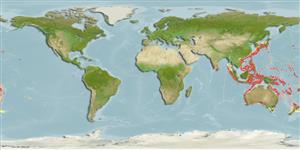Actinopterygii (ray-finned fishes) >
Ateleopodiformes (Jellynose fishes) >
Ateleopodidae (Jellynose fishes)
Etymology: Ateleopus: Greek, ateles = imperfect + Greek, pous = foot (Ref. 45335). More on author: Bleeker.
Environment / Climate / Range
Ecology
Marine; bathydemersal; depth range 140 - 600 m (Ref. 44036). Deep-water, preferred ?
Western Pacific: southern Japan. More recent works report of its occurrence in Taiwan (Ref. 5193), Malaysia (Ref. 5756) and the Chesterfield Islands (Ref. 11897).
Size / Weight / Age
Maturity: Lm ? range ? - ? cm
Max length : 95.0 cm SL male/unsexed; (Ref. 559); common length : 35.0 cm NG male/unsexed; (Ref. 27550)
Dorsal
spines
(total): 0;
Dorsal
soft rays
(total): 8-10;
Anal
spines: 0. Longest ray of pelvic fin thin, long reaching to or near tip of pectoral fin. Lip of upper jaw thin. Upper jaw with a short band of villiform teeth; lower jaw, palatine, pre vomer and tongue toothless. Body purplish-brown, semi-transparent. Attain 95 cm SL.
Feeds on prawns (Ref. 27550).
Life cycle and mating behavior
Maturity | Reproduction | Spawning | Eggs | Fecundity | Larvae
Masuda, H., K. Amaoka, C. Araga, T. Uyeno and T. Yoshino, 1984. The fishes of the Japanese Archipelago. Vol. 1. Tokai University Press, Tokyo, Japan. 437 p. (text). (Ref. 559)
IUCN Red List Status (Ref. 115185)
CITES (Ref. 94142)
Not Evaluated
Threat to humans
Harmless
Human uses
Fisheries: of no interest
More information
Common namesSynonymsMetabolismPredatorsEcotoxicologyReproductionMaturitySpawningFecundityEggsEgg development
ReferencesAquacultureAquaculture profileStrainsGeneticsAllele frequenciesHeritabilityDiseasesProcessingMass conversion
Tools
Special reports
Download XML
Internet sources
